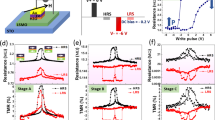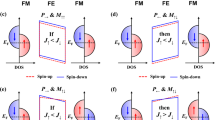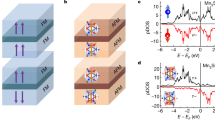Abstract
Spin-polarized transport in ferromagnetic tunnel junctions, characterized by tunnel magnetoresistance1, has already been proven to have great potential for application in the field of spintronics2 and in magnetic random access memories3. Until recently, in such a junction the insulating barrier played only a passive role, namely to facilitate electron tunnelling between the ferromagnetic electrodes. However, new possibilities emerged when ferroelectric materials were used for the insulating barrier, as these possess a permanent dielectric polarization switchable between two stable states4,5,6,7,8,9. Adding to the two different magnetization alignments of the electrode, four non-volatile states are therefore possible in such multiferroic tunnel junctions10,11. Here, we show that owing to the coupling between magnetization and ferroelectric polarization at the interface between the electrode and barrier of a multiferroic tunnel junction, the spin polarization of the tunnelling electrons can be reversibly and remanently inverted by switching the ferroelectric polarization of the barrier. Selecting the spin direction of the tunnelling electrons by short electric pulses in the nanosecond range rather than by an applied magnetic field enables new possibilities for spin control in spintronic devices12.
This is a preview of subscription content, access via your institution
Access options
Subscribe to this journal
Receive 12 print issues and online access
$259.00 per year
only $21.58 per issue
Buy this article
- Purchase on Springer Link
- Instant access to full article PDF
Prices may be subject to local taxes which are calculated during checkout



Similar content being viewed by others
References
Jullière, M. Tunneling between ferromagnetic films. Phys. Lett. A 54, 225–226 (1975).
Wolf, S. A. et al. Spintronics: A spin-based electronics vision for the future. Science 294, 1488–1495 (2001).
Slaughter, J. M. Materials for magnetoresistive random access memory. Annu. Rev. Mater. Res. 39, 277–296 (2009).
Tsymbal, E. Y. & Kohlstedt, H. Tunneling across a ferroelectric. Science 313, 181–183 (2006).
Gajek, M. et al. Tunnel junctions with multiferroic barriers. Nature Mater. 6, 296–302 (2007).
Garcia, V. et al. Ferroelectric control of spin polarization. Science 327, 1106–1110 (2010).
Hambe, M. et al. Crossing an interface: Ferroelectric control of tunnel currents in magnetic complex oxide heterostructures. Adv. Funct. Mater. 20, 2436–2441 (2010).
Yin, Y. W. et al. Coexistence of tunneling magnetoresistance and electroresistance at room temperature in La0.7Sr0.3MnO3/(Ba,Sr)TiO3/La0.7Sr0.3MnO3 multiferroic tunnel junctions. J. Appl. Phys. 109, 07D915 (2011).
Valencia, S. et al. Interface-induced room-temperature multiferroicity in BaTiO3 . Nature Mater. 10, 753–758 (2011).
Scott, J. F. Data storage: Multiferroic memories. Nature Mater. 6, 256–257 (2007).
Velev, J. P. et al. Magnetic tunnel junctions with ferroelectric barriers: Prediction of four resistance states from first principles. Nano Lett. 9, 427–432 (2009).
Ramesh, R. Ferroelectrics: A new spin on spintronics. Nature Mater. 9, 380–381 (2010).
Park, J-H. et al. Direct evidence for a half-metallic ferromagnet. Nature 392, 794–796 (1998).
De Teresa, J. M. et al. Role of metal-oxide interface in determining the spin polarization of magnetic tunnel junctions. Science 286, 507–509 (1999).
Bowen, M. et al. Nearly total spin polarization in La2/3Sr1/3MnO3 from tunneling experiments. Appl. Phys. Lett. 82, 233–235 (2003).
Pantel, D., Goetze, S., Hesse, D. & Alexe, M. Room temperature ferroelectric resistive switching in ultra-thin Pb(Zr0.2Ti0.8)O3 films. ACS Nano 5, 6032–6038 (2011).
Zhuravlev, M. Y., Jaswal, S. S., Tsymbal, E. Y. & Sabirianov, R. F. Ferroelectric switch for spin injection. Appl. Phys. Lett. 87, 222114 (2005).
Fechner, M., Ostanin, S. & Mertig, I. Effect of oxidation of the ultrathin Fe electrode material on the strength of magnetoelectric coupling in composite multiferroics. Phys. Rev. B 80, 094405 (2009).
Zhuravlev, M. Y., Maekawa, S. & Tsymbal, E. Y. Effect of spin-dependent screening on tunneling electroresistance and tunneling magnetoresistance in multiferroic tunnel junctions. Phys. Rev. B 81, 104419 (2010).
Burton, J. D. & Tsymbal, E. Y. Prediction of electrically induced magnetic reconstruction at the manganite/ferroelectric interface. Phys. Rev. B 80, 174406 (2009).
Van de Veerdonk, R. J. M., Nowak, J., Meservey, R., Moodera, J. S. & de Jonge, W. J. M. Current distribution effects in magnetoresistive tunnel junctions. Appl. Phys. Lett. 71, 2839–2841 (1997).
Åkerman, J. J., Slaughter, J. M., Dave, R. W. & Schuller, I. K. Tunneling criteria for magnetic-insulator-magnetic structures. Appl. Phys. Lett. 79, 3104–3106 (2001).
Vera Marún, I. J., Postma, F. M., Lodder, J. C. & Jansen, R. Tunneling magnetoresistance with positive and negative sign in La0.67Sr0.33MnO3/SrTiO3/Co junctions. Phys. Rev. B 76, 064426 (2007).
Brinkman, W. F., Dynes, R. C. & Rowell, J. M. Tunneling conductance of asymmetrical barriers. J. Appl. Phys. 41, 1915–1921 (1970).
Junquera, J. & Ghosez, P. Critical thickness for ferroelectricity in perovskite ultrathin films. Nature 422, 506–509 (2003).
Kay, H. F. & Dunn, J. W. Thickness dependence of the nucleation field of triglycine sulphate. Phil. Mag. 7, 2027–2034 (1962).
Kalinin, S., Jesse, S., Tselev, A., Baddorf, A. P. & Balke, N. The role of electrochemical phenomena in scanning probe microscopy of ferroelectric thin films. ACS Nano 5, 5683–5691 (2011).
Kobayashi, K-I., Kimura, T., Sawada, H., Terakura, K. & Tokura, Y. Room-temperature magnetoresistance in an oxide material with an ordered double-perovskite structure. Nature 395, 677–680 (1998).
Velev, J. P., Jaswal, S. S. & Tsymbal, E. Y. Multi-ferroic and magnetoelectric materials and interfaces. Phil. Trans. R. Soc. A 369, 3069–3097 (2011).
Fechner, M. et al. Magnetic phase transition in two-phase multiferroics predicted from first principles. Phys. Rev. B 78, 212406 (2008).
Oleinik, I. I., Tsymbal, E. Y. & Pettifor, D. G. Atomic and electronic structure of Co/SrTiO3/Co magnetic tunnel junctions. Phys. Rev. B 65, 020401 (2001).
Bocher, L. et al. Atomic and electronic structure of the BaTiO3/Fe interface in multiferroic tunnel junctions. Nano Lett. 12, 376–378 (2012).
Zhang, S. Spin-dependent surface screening in ferromagnets and magnetic tunnel junctions. Phys. Rev. Lett. 83, 640–643 (1999).
Tsymbal, E. Y., Sokolov, A., Sabirianov, I. F. & Doudin, B. Resonant inversion of tunneling magnetoresistance. Phys. Rev. Lett. 90, 186602 (2003).
Bowen, M. et al. Bias-crafted magnetic tunnel junctions with bistable spin-dependent states. Appl. Phys. Lett. 89, 103517 (2006).
Acknowledgements
This work has been supported by the German Science Foundation (DFG) through SFB 762. We are grateful to N. Schammelt for technical assistance and G. Schmidt for useful discussions. We thank P. Werner for help with HRTEM.
Author information
Authors and Affiliations
Contributions
D.P. and M.A. designed the experiments; D.P. carried out the experiments; S.G. and D.P. prepared the samples; S.G. carried out the TEM investigations; D.P. and M.A. analysed and discussed the results; D.P., M.A. and D.H. prepared the manuscript.
Corresponding author
Ethics declarations
Competing interests
The authors declare no competing financial interests.
Supplementary information
Supplementary Information
Supplementary Information (PDF 656 kb)
Rights and permissions
About this article
Cite this article
Pantel, D., Goetze, S., Hesse, D. et al. Reversible electrical switching of spin polarization in multiferroic tunnel junctions. Nature Mater 11, 289–293 (2012). https://doi.org/10.1038/nmat3254
Received:
Accepted:
Published:
Issue Date:
DOI: https://doi.org/10.1038/nmat3254
This article is cited by
-
Electrical switching of spin-polarized current in multiferroic tunneling junctions
npj Computational Materials (2022)
-
Real-space observation of ferroelectrically induced magnetic spin crystal in SrRuO3
Nature Communications (2021)
-
Reversal of the magnetoelectric effect at a ferromagnetic metal/ferroelectric interface induced by metal oxidation
npj Computational Materials (2021)
-
Vector analysis of electric-field-induced antiparallel magnetic domain evolution in ferromagnetic/ferroelectric heterostructures
Journal of Advanced Ceramics (2021)
-
Quasiparticle tunnel electroresistance in superconducting junctions
Nature Communications (2020)



